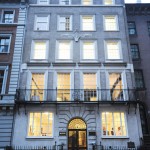The increased awareness to impending climate challenges, especially those facing global coastal cities, has heightened the need for dynamic solutions to threats like rising sea levels, storm surge and the urban heat island phenomenon.
Recognizant of these potential infrastructure dangers, New York City has pioneered revolutionary waterfront development proposals, designed to buffer against sea level rise-driven storm surges like those experienced during Hurricane Sandy. The Special Initiative for Rebuilding and Resiliency report on Coastal Protection indicates that by 2050, 43 miles of coastline—8% of the city’s total —could be at risk of daily or weekly tidal flooding in normal weather conditions. The same report cites that with increasing sea levels, 24% of the city’s land area could be at risk during a 100-year storm event by the 2050s.
Hurricane Sandy caused the damage and destruction of 305,000 homes, and cost an estimated $19 billion in losses. Southern Manhattan, where power was disrupted during Sandy, has been increasingly important to city operations and the larger New York region. It is clear that New York City needs comprehensive and sustainable solutions, especially in Southern Manhattan, where wave energy is funneled due to the unique geography of the New York Harbor.
An innovative proposal, ‘Seaport City’, has garnered attention for its ambitious purpose to expand the Southern Manhattan waterfront into a developable storm surge barrier. Pioneered by the engineering firm ‘Arcadis’, and the NYC Economic Development Corp, Seaport City offers 4 different proposals for expanding the battery through fill construction over the East River. Each includes developable park, commercial, and residential spaces. The largest of the proposals, a 500-foot Land Reclamation levee, would create 6.7 million square feet of commercial space, roughly 13,100 mixed-income residential units, 1.5 million square feet of community facility space, and 30 acres of new parks and open land. Arcadis references that the levee would be 19 feet tall, and able to withstand 100-year flooding events under projected 2100 sea levels. Unfortunately, this height is unable to guarantee complete protection, with storm surges reaching 23 feet during 500 year flooding events. Along with a construction time upwards of 56 years, and a cost at nearly $3.9 billion, Seaport City becomes a relatively unfeasible project. Despite these setbacks, the installation of a multi-purpose levee still represents a novel idea, embodying a duality of resilience and social efficacy.
The Rebuild by Design competition, launched in response to Hurricane Sandy, has sought to attract unique ideas regarding the future of resilience infrastructure. The Dryline, the brain-child of visionary architect Bjarke Ingels, has inspired revolutionary thoughts on the future of urban design. It encompasses a comprehensive system of protective park structures, stretching from W57th Street to the Battery, then north to E42nd St. The plan evokes a sense of urban utopia, utilizing vertical landscaped protective berms, salt-tolerant plants, landscaped bridges, public space, and deployable storm walls decorated by local artists. It responded to comprehensive flood protection through a core design set of community needs, physical and social resiliency, and community benefit. Fortunately, the East River portion has secured funding from the Department of Housing and Urban Development (HUD), with the remainder pending federal budget requests.
Although these projects are on the cutting edge of possibility in New York City’s climate response, there is still more work to be done in defining the role of cities in adaption and design. It can be argued that global responses to climate change must come in the form of deeply needed cuts in carbon emissions, retrofits in building efficiency, adoption of cleaner energy, and awareness building in environmental education. Despite these valid considerations, leaders like Mr. Ingels will have profound influences in the realm of urban planning and how we utilize our spaces to influence human behavior and learning.








